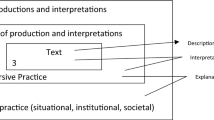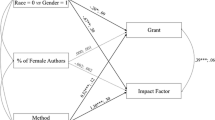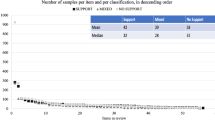Abstract
This paper seeks to investigate whether recent improvements in the status of women in Hong Kong are reflected in patterns of gender representation in Hong Kong secondary English textbooks. A comparison of ten recently published books which are currently in use with ten published in the late 1980s/early 1990s and no longer in use revealed that women appeared more frequently in the former, and that greater use was made of gender-inclusive pronouns and the neutral address title Ms. Nevertheless some writers, it was found, continue to perpetuate the stereotyped image of women as weaker than men, and as operating primarily within domestic rather than social domains. The “male-first” phenomenon and the visual under-representation of women are still prevalent in recent textbooks.
Similar content being viewed by others
References
Apple, M. W. (1990). The text and cultural politics. The Journal of Educational Thought, 24(3A), 17–33.
Atkins-Sayre, W. (2005). Naming women: The emergence of “Ms.” as a liberatory title. Women and Language, 28, 8–16.
區潔珍 Au, K. C (1993) 香港小學課本裡的性別角色硏究 (Study of gender roles in Hong Kong primary textbooks). Occasional paper (Hong Kong Institute of Asia-Pacific Studies), 18. 香港: 香港中文大學香港亞太硏究所
Balhorn, M. (2004). The rise of epicene they. Journal of English Linguistics, 32, 79–104.
Briere, J., & Lanktree, C. (1983). Sex-role related effects of sex bias in language. Sex Roles, 9, 625–632.
Britton, G. E., & Lumpkin, M. C. (1977). For sale: Subliminal bias in textbooks. The Reading Teacher, 31(1), 40–45.
Burchfield, R. (1981). The spoken word: A BBC guide. London: British Broadcasting Corporation.
Census and Statistics Department (2002). 2001 population census: Main report, vol 1. Hong Kong: Government Printer.
Census and Statistics Department (2007). 2006 population by-census summary results. Retrieved 23 February 2007 from http://www.bycensus2006.gov.hk/data/data2/index.htm.
Chan, A. (2000). Keynote address. Proceedings: Hong Kong perspectives on Beijing+5. Hong Kong: Equal Opportunities Commission.
鄭宇碩 Cheng, Y. S. (2006, March 20). 「晨早新聞天地」節目內之訪問 (Interview broadcast in Morning News World). 香港電台第一台 (Radio 1, Radio Television Hong Kong).
Cincotta, M. S. (1978). Textbooks and their influence on sex-role stereotype formation. BABEL: Journal of the Australian Federation of MLTS Associations, 14(3), 24–29.
Cole, D. M., Hill, F. A., & Dayley, L. J. (1983). Do masculine pronouns used generically lead to thoughts of men? Sex Roles, 9, 737–750.
Crawford, M., & English, L. (1984). Generic versus specific inclusion of women in language: Effects on recall. Journal of Psycholinguistic Research, 13, 373–381.
Curriculum Development Council Ad Hoc Committee on Textbook Quality (2003). Guiding principles for quality textbooks. Retrieved 10 July 2007 from http://www.edb.gov.hk/index.aspx?langno=1&nodeid=2842.
Eckert, P., & McConnell-Ginet, S. (2003). Language and gender. Cambridge: Cambridge University Press.
Equal Opportunities Commission (2000). Research on content analysis of textbooks and teaching materials in respect of stereotypes: Executive summary. Hong Kong: Hong Kong Printer.
Evans, L., & Davies, K. (2000). No sissy boys here: A content analysis of the representation of masculinity in elementary school reading textbooks. Sex Roles, 41, 255–270.
Fowler, H. W. (1965). A dictionary of modern English usage (revised by Sir Ernes Gowers). Oxford: Clarendon.
Frasher, R., & Walker, A. (1972). Sex roles in early reading textbooks. The Reading Teacher, 25, 741–749.
Greenbaum, S. (1996). The Oxford English grammar. Oxford: Oxford University Press.
Hamilton, M. C. (1988). Using masculine generics: Does generic he increase male bias in the user’s imagery? Sex Roles, 19, 785–799.
Hartman, P. L., & Judd, E. L. (1978). Sexism and TESOL materials. TESOL Quarterly, 12, 383–393.
Hellinger, M. (1980). “For men must work, and women must weep”: Sexism in English language textbooks used in German schools. Women’s Studies International Quarterly, 3, 267–275.
Holmes, J. (2001). A corpus-based view of gender in New Zealand. In M. Hellinger, & H. Bussmann (Eds.) Gender across languages: The linguistic representation of women and men, vol 1 (pp. 115–136). Amsterdam: John Benjamins.
Jochnowitz, G. (1982). Everybody likes pizza, doesn’t he or she? American Speech, 57, 198–203.
Jones, M. A., Kitetu, C., & Sunderland, J. (1997). Discourse roles, gender and language textbook dialogues: Who learns what from John and Sally? Gender and Education, 9, 469–490.
Law, K. W. K., & Chan, A. H. N. (2004). Gender role stereotyping in Hong Kong’s primary school Chinese language subject textbooks. Asian Journal of Women’s Studies, 10, 49–69.
Lillian, D. L. (1995). Ms. revisited: She’s still a bitch, only now she’s older!. Linguistica Atlantica, 19, 149–161.
Macaulay, M., & Brice, C. (1997). Don’t touch my projectile: Gender bias and stereotyping in syntactic examples. Language, 73, 798–825.
Mannheim, C. (1994). “The boss was called Mr Power”: Learners’ perspectives on sexism in EFL materials. In J. Sunderland (Ed.) Exploring gender: Questions and implications for English language education (pp. 83–91). New York: Prentice Hall.
Partridge, E. (1965). Usage and abusage. London: Hamilton.
Pauwels, A. (2001a). Non-sexist language reform and generic pronouns in Australian English. English World-Wide, 22, 105–119.
Pauwels, A. (2001b). Spreading the feminist word: The case of the new courtesy title Ms in Australian English. In M. Hellinger, & H. Bussmann (Eds.) Gender across languages: The linguistic representation of women and men, vol. 1 (pp. 137–151). Amsterdam: Benjamins.
Pauwels, A. (2003). Linguistic sexism and feminist linguistic activism. In J. Holmes, & M. Meyerhoff (Eds.) The handbook of language and gender (pp. 550–570). Malden, MA: Blackwell.
Peters, P. (2004). The Cambridge guide to English usage. Cambridge: Cambridge University Press.
Peterson, S. B., & Lach, M. A. (1990). Gender stereotypes in children’s books: Their prevalence and influence on cognitive and affective development. Gender and Education, 2, 185–197.
Porreca, K. L. (1984). Sexism in current ESL textbooks. TESOL Quarterly, 18, 705–724.
Sunderland, J., et al. (1997). Gender in language textbooks: Looking beyond textual imbalance. Lancaster: Centre for Research in Language Education, Lancaster University.
Sunderland, J., et al. (2001). From bias “in the text” to “teacher talk around the text”: An exploration of teacher discourse and gendered foreign language textbook texts. Linguistics and Education, 11, 251–286.
Wong, T. W. P. (1995). Women and work: Opportunities and experiences. In V. Pearson & B. K. P. Leung (Eds.), Women in Hong Kong (pp. 47–73). HongKong: Oxford University Press.
游黎麗玲、 陸鴻基 Yau-Lai, L. L., & Luk, H. K. (1988). 香港初中中史科和社 會科課本裡的性別角色研究 (Gender roles as defined in current social studies subjects textbooks at the junior secondary level in Hong Kong). 香港: 香港中 文大學社會研究所
Acknowledgements
We would like to express our gratitude to the three reviewers and the editor for their valuable comments on the earlier drafts of this article. This article is one of the outcomes of a project, “Gender Representation in ESL Textbooks—The Cases of Hong Kong and Australia”, which was supported by a research grant from the Hong Kong Institute of Education.
Author information
Authors and Affiliations
Corresponding author
Appendix
Appendix
Earlier Textbooks
E1: Christie, H., Yuen, K. S., & Nancarrow, C. (1994). English: A modern course 1. Hong Kong: Aristo.
E2: Christie, H., & Yuen, K. S. (1994). English: A modern course 5. Hong Kong: Aristo.
E3: Methold, K., & Tadman, J. (1990). New integrated English 1. Hong Kong: Longman.
E4: Methold, K., Tadman, J., & Lam, J. (1990). New integrated English 5. Hong Kong: Longman.
E5: Howe, D. H., Kirkpatrick, T. A., & D. L. (1986). Access today 1. Hong Kong: Oxford University Press.
E6: Howe, D. H., Kirkpatrick, T. A., & D. L. (1986). Access today 5. Hong Kong: Oxford University Press.
E7: Mackay, R., & Byron, S. (1994). Impact 1. Hong Kong: Macmillan.
E8: Smallwood, I. M., & Walsh, S. (1994). Impact 5. Hong Kong: Macmillan.
E9: Etherton, A. R. B. (1986). Creative English for secondary schools 1. Hong Kong: Ling Kee.
E10: Etherton, A. R. B. (1988). Creative English for secondary schools 5. Hong Kong: Ling Kee.
Recent Textbooks
R1: Williams, A., & Dawson, C. (2004). New English treasure 1B. Hong Kong: Oxford University Press.
R2: Dixon, M., Kent, J. C., Norberg, M., & Williams, A. (2006). New progress 4A. Hong Kong: Oxford University Press.
R3: Kent, J. C., & Hodson, R. (2003). Progress 5. Hong Kong: Oxford University Press.
R4: Sampson, N. (2001). New way to English 2A. Hong Kong: Macmillan.
R5: Li, P. L., Leetch, P., & Burns, G. J. (2001). Real English 1B. Hong Kong: Macmillan.
R6: Sampson, N. (1997). English 2000, 5. Hong Kong: Macmillan.
R7: Nancarrow, C., Thomas, G., & Yuen, K. S. (2004). Living English 1A. Hong Kong: Aristo.
R8: Nancarrow, C., Hsing, B. M., & Yuen, K. S. (2004). Living English for the Certificate Exam 4A. Hong Kong: Aristo.
R9: Nelson, J. A., Chan, K., & Swan, A. (2004). Longman express 1B. Hong Kong: Longman.
R10: Vickers, E., Wheeler, J., & Lee, I. (2003). Longman express 5. Hong Kong: Longman.
Rights and permissions
About this article
Cite this article
Lee, J.F.K., Collins, P. Gender Voices in Hong Kong English Textbooks—Some Past and Current Practices. Sex Roles 59, 127–137 (2008). https://doi.org/10.1007/s11199-008-9414-6
Received:
Accepted:
Published:
Issue Date:
DOI: https://doi.org/10.1007/s11199-008-9414-6




